Vacuum Pumps understanding Various
Claw type dry vacuum pump, water ring vacuum pump, screw type dry vacuum pump, reciprocating vacuum pump, water jet vacuum pump, rotary vane type vacuum pump, slide valve type vacuum pump, Roots vacuum pump, oil diffusion vacuum pump, molecular pump and titanium sublimation pump are 11 kinds of pumps.
1. Claw type dry vacuum pump
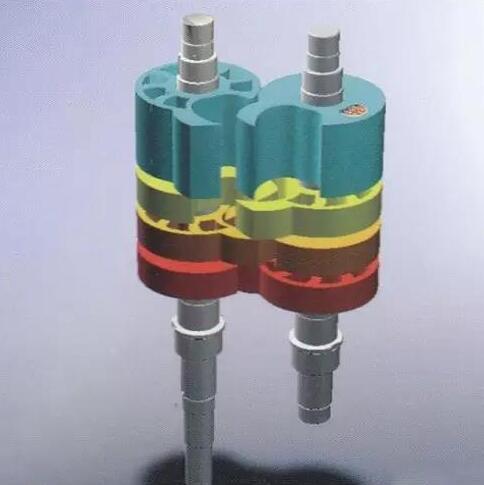

Claw Dry Vacuum Pump working Principle:
Claw-type dry oil-free vacuum pump has several groups of claw-type rotors intermeshing in the pump chamber. There is no contact between the rotor and the rotor, and between the rotor and the pump chamber, leaving a small gap, without any lubricant, thus ensuring a clean vacuum environment. The structure of the pump adopts the form of multi-stage rotor channeling, each group of rotors is located in different pump chambers to do synchronous reverse movement. The pump chamber is separated by a claw rotor into two parts: the suction chamber and the exhaust chamber. With the continuous operation of the rotor, the cycle of suction and exhaust process, to achieve the purpose of continuous pumping.
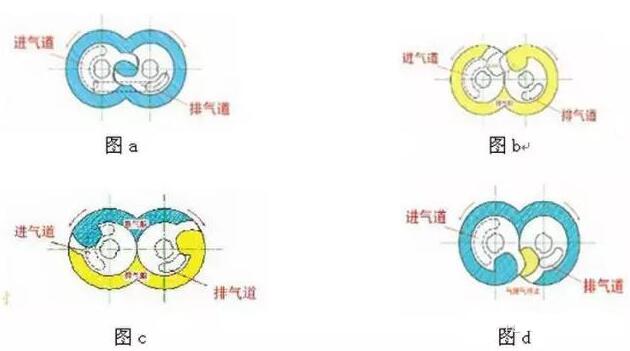
The above picture shows the pumping process of Roots rotor from 0 to 360. At the position of 0 degrees (Fig. a), the intake and exhaust ports are closed, the suction chamber communicates with the exhaust chamber, and the pressure in the pump chamber is equally balanced. When the two rotors rotate to 50 degrees (Fig. b), a negative pressure chamber is formed. The inlet opens and the pressure of the positive pressure chamber increases gradually. In the working process, this position is the moment when the rotor is in the balance of pressure in the reversing pump chamber. When the rotor rotates from this position to a certain angle, the rotor begins to seal and divide into two parts: the suction chamber and the compressed exhaust chamber. At this time, work begins. At this position, the intake opens, and as the rotor continues to rotate the negative pressure chamber, the volume of the exhaust chamber gradually increases and begins to suck, and the volume of the exhaust chamber gradually decreases. Because the exhaust outlet has not been opened, the gas is compressed, and the compression varies with the position of the upper line of the exhaust outlet. When the rotor rotates to 155 degrees, the negative pressure chamber continues to intake, the exhaust duct opens and starts to exhaust. At this position, the suction work of the pump continues, the exhaust port begins to open, and the compressed gas is quickly discharged into the next stage of the pump chamber. When the rotor rotates to 312 degrees, the intake and exhaust ports are closed. At this position, the rotor works to complete a cycle, at which time the pressure in the pump chamber gradually returns to equilibrium. (Fig. d) This position returns to the initial position. With the continuous rotation of the pump rotor, the process of suction and exhaust circulates, which realizes the continuous pumping work of the pump and realizes the purpose of vacuum pumping. The rotor is not rotated once, and the suction and exhaust are carried out once each.
Claw Dry Vacuum Pump Characteristics:
1. The pump chamber does not contain any medium, such as oil, and is clean for pumping. It does not pollute the environment.
2. High vacuum, up to 3 3a;
3. It has simple structure, easy operation and maintenance, and low operation cost.
4. It can work continuously under high pressure for a long time with low noise.
5. It can extract corrosive gases, toxic gases, flammable and explosive gases, radioactive gases, dust-containing gases and condensable gases (such as water vapor, organic gases, etc.).
6. It can be used as a gas transmission pump with good compression ratio up to 10-105.
7. The rotor pair is suspended in the pump chamber, the rotor pair is not in contact with the pump chamber, there is no friction, and the service life is long.
Claw Dry Vacuum Pump Application :
Petrochemical industry:(1) It can extract acidic gases, such as tetrahydrofuran. (2) Can extract condensable gases, such as alcohol, gasoline, etc. (3) It can extract flammable and explosive gases, such as oxygen, hydrogen, methane, etc. (4) Antiseptic series can extract strong acidic gases, such as hydrogen chloride, hydrogen fluoride, sulfuric acid, etc.
Pharmaceutical industry:Crystallization, distillation, sublimation, drying, deodorization, polymerization, vacuum evaporation, negative pressure filtration, monomer recovery, adsorption/desorption, material transport decay, corrosive media, ethylene oxide disinfection, etc.
Food industry:Sublimation, drying, dehydration, vacuum evaporation, vacuum preservation, vacuum packaging, etc.
Scientific research institutes:Rotary steaming, distillation, distillation, polymerization, vacuum filtration, vacuum drying, pilot plant, wind tunnel test, vacuum environment simulation, etc.
Electron photovoltaic: impregnation, vacuum coating, ion etching, molecular beam epitaxy, etc.
Aerospace and Aerospace: Brazing, Vacuum Coating, Electron Beam Welding, Wind Tunnel Test, Space Environment Simulation, etc.
Metallurgical industry: impregnation, extrusion, vacuum coating, ion etching, sludge degassing, molten steel degassing, molecular beam epitaxy, etc.
Nuclear industry: zero leakage claw pump can remove UF6 gas
Other industries: central air conditioning, indoor vacuum, sewage treatment, lithium battery manufacturing, etc.
2.Water ring vacuum pump
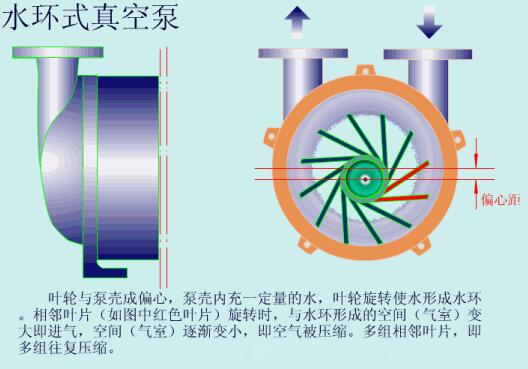
Water Ring Vacuum Pump Working Principle :
Water-ring vacuum pump (hereinafter referred to as water-ring pump) is a kind of coarse vacuum pump. The maximum vacuum it can obtain is 2000-4000Pa, and the air ejector in series can reach 270-670Pa. Water ring pump can also be used as a compressor, known as water ring compressor, is a low-pressure compressor, its pressure range is 1-2*105Pa gauge pressure.
Because the gas compression in the water ring pump is isothermal, it can extract flammable and explosive gases, in addition, it can extract dust and water-bearing gases. Therefore, the application of the water ring pump is increasing.
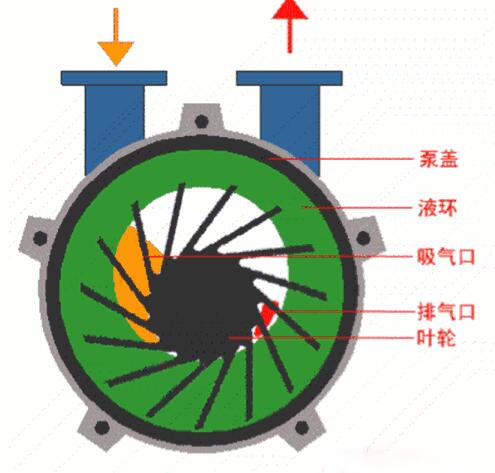
The working principle of water ring vacuum pump is as follows: the impeller is eccentrically installed in the pump body, and a certain height of water is injected into the pump as working fluid when starting. When the impeller rotates clockwise in the direction indicated in the figure, the water is thrown around by the impeller. Due to the action of centrifugal force, the water forms a closed ring which is approximately equal in thickness depending on the shape of the pump chamber. The inner surface of the upper part of the water ring is just tangent to the hub of the impeller, and the inner surface of the lower part of the water ring is just in contact with the top of the blade (in fact, the blade has a certain insertion depth in the water ring).
At this time, a crescent-shaped space is formed between the hub and the water ring of the impeller, which is divided into several small cavities with equal number of blades by the impeller. If the starting point is 0 degrees above the impeller, then the small chamber is connected with the suction port on the end surface at 180 degrees before the impeller rotates, and the volume increases from small to large and the pressure decreases continuously when the impeller rotates. When the pressure is lower than the pressure of the sucked container, the sucked gas is continuously pumped in, and when the suction ends, the cavity is isolated from the suction port; when the impeller continues to rotate, the cavity is connected with the exhaust port, and the cavity is large. Reduce, so that the gas is constantly compressed, when the pressure of the gas is stronger than the exhaust pressure, the gas is discharged out of the pump. Water ring pump is a variable-volume vacuum pump, which relies on the volume change of pump chamber to achieve aspiration, compression and exhaust.
Basic Types and Characteristics of Water Ring Vacuum Pump
Water ring pumps can be divided into the following types according to different structures:
(1) Single-stage single-acting water ring pump: single-stage refers to only one impeller, single-acting refers to the impeller every rotating cycle, suction and exhaust once. This kind of pump has higher limit vacuum, but lower pumping speed and efficiency.
(2) Single-stage double-acting water ring pump: single-stage refers to only one impeller, double-acting refers to the impeller every rotation of a week, suction, exhaust twice. Under the same pumping speed, the size and weight of double-acting water ring pump are much smaller than that of single-acting water ring pump. Because the working chamber is symmetrically distributed on both sides of the pump hub, the load acting on the rotor is improved. The pumping speed and efficiency of this kind of pump are higher, but the limit vacuum is lower.
(3) Two-stage water ring pumps: Most of the two-stage water ring pumps are single-acting pumps in series. Essentially, the impellers of two single-stage single-acting water ring pumps are joined together by a common spindle. Its main characteristic is that it still has a large pumping speed at a higher vacuum, and its working condition is stable.
(4) Atmospheric Water Ring Pump: Atmospheric Water Ring Pump is actually a unit of air ejector series water ring pump. The air pump in series in front of the water ring pump is designed to improve the limit vacuum and expand the use of the pump.
water ring vacuum pump advantages :
(1) The structure is simple, the manufacturing accuracy is not high, and it is easy to process. Simple operation and convenient maintenance.
(2) Compact structure, the pump is usually directly connected with the motor, and the speed is high. With smaller structure size, larger exhaust volume can be obtained.
(3) There is no metal friction surface in the pump chamber, so there is no need to lubricate the pump. The sealing between the rotating part and the fixing part can be accomplished directly by the water seal.
(4) The temperature change of the compressed gas in the pump chamber is very small, which can be regarded as isothermal compression. Therefore, flammable and explosive gases can be removed.
(5) Because there is no exhaust valve and friction surface, dust-laden gas, condensable gas and gas-water mixture can be removed.
water ring vacuum pump disadvantages:
(1) Low efficiency, generally around 30%, better up to 50%.
(2) Low vacuum. This is not only due to structural constraints, but also to the saturated vapor pressure of the working fluid.
Generally speaking, water ring pump has been widely used because of its outstanding advantages of isothermal compression and water sealing, which can extract flammable, explosive and corrosive gases, dust and moisture.
Water Ring Vacuum Pump Application :
Power industry application: condenser vacuum pumping, vacuum water absorption, flue gas desulfurization, fly ash transportation, turbine sealed pipe exhaust (public number: pump manager), vacuum exhaust, geothermal exhaust.
Petrochemical industry application: gas recovery, gas recovery, gas pressurization, enhanced oil recovery, gas collection, crude oil stabilization, vacuum distillation of crude oil, exhaust compression, steam recovery/gas pressurization, filtration/dewaxing, tail gas recovery, polyester production, PVC production, packaging, cyclic gas compression, pressure swing adsorption (PSA), production, acetylene and hydrogen, etc. Explosive gas compression, vacuum system on top of tower in vacuum distillation of crude oil, vacuum crystallization and drying, vacuum filtration and vacuum transportation of various materials.
Manufacturing industries application: drying (pallets, rotations, reversals, cones and freeze dryers), reproducing/reactor drying, distillation, degassing, crystallization/vaporization, filling and/or material transfer.
Pulp and paper production application: black liquor evaporation, crude pulp washer, lime slurry and filter, precipitate filter, vacuum dehydrator, raw material and white water degassing system, mixing box compressor, suction box, suction roll and transfer roll, vacuum pressing, wool suction box, blower box.
Plastic industry application: extruder degassing, setting table (profile), EPS foaming, drying, pneumatic conveying device, vinyl chloride gas extraction and compression.
Application in instruments: Steam sterilization, breathing device, pneumatic mattress, protective clothing, dental instrument, central vacuum system.
Environmental protection industry application: wastewater treatment, biogas compression, vacuum water addition, wastewater purification/activated sludge tank oxidation, fish pond ventilation, waste gas recovery (biogas), biogas recovery (biogas), waste treatment machine.
Food and beverage industry application: salmon cleaner, mineral water degassing, salad oil and fat deodorization, tea and condiment sterilization, sausage and ham production, tobacco products humidification, vacuum evaporator.
Packaging industry application: filling bags with air, opening bags by means of air extraction, transporting packaging materials and products, attaching labels and packing articles with glue, lifting cardboard boxes by means of vacuum manipulators, and assembling, vacuum packaging and ventilation packaging (MAP), PET container production, drying of plastic particles, conveying and extruding of plastic particles. Machine degassing, injection moulding, film removal and treatment of injection moulding parts, drying of injection moulding parts, blow moulding of bottles, plasma treatment, to set up isolation layer, pneumatic conveying of bottles, filling and filling, labeling, packaging and moulding, recycling.
Wood processing industry application: maintenance and snatch, wood drying, wood preservation, log impregnation.
Marine industry application: condenser exhaust, central vacuum pumping, marine low pressure air compressor, turbine sealed pipe exhaust.
Facility treatment application: drying floor, water pipeline anti-corrosion protection, central vacuum cleaning system.
Metallurgical industry application: steel degassing.
Sugar industry application : preparation of carbon dioxide, filtrate of dirt, application in evaporator and vacuum sucker.
3.Screw Dry Vacuum Pump

Screw Dry Vacuum Pump Working Principle :
The working cycle of screw pump can be divided into three processes: suction, compression and exhaust. As the rotor rotates, each pair of meshing teeth completes the same working cycle one after another, which is illustrated by one pair of teeth.
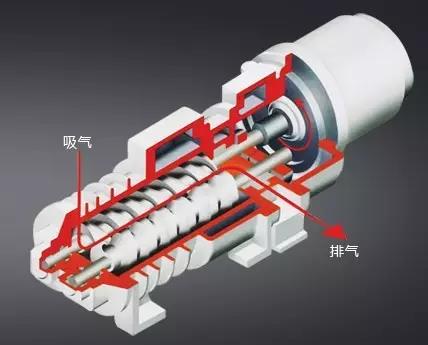
1. Inhalation process
The following figure shows the suction process of the screw pump. A pair of teeth studied are marked with arrows. In the figure, the positive rotor rotates counterclockwise while the negative rotor rotates clockwise. The rotor end in the figure is the inspiratory end.
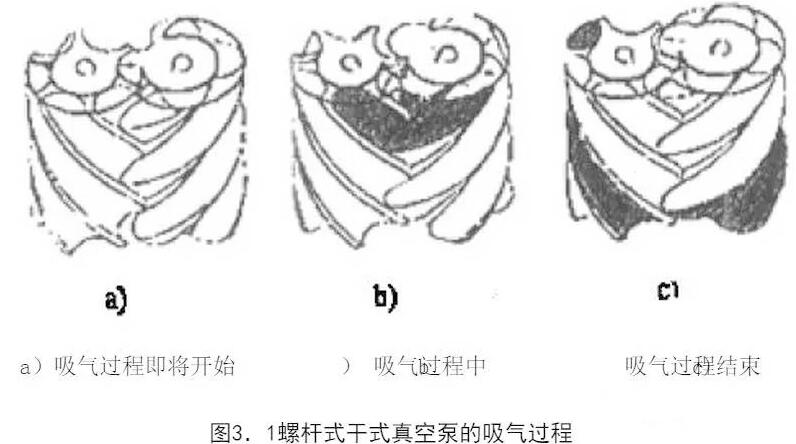
Figure a shows the rotor position at the beginning of the suction process. At this moment, the front profile of the pair of teeth is fully meshed and will be connected with the suction port. As the rotor begins to rotate, the volume between the teeth is formed because one end of the teeth is gradually separated from the mesh. The volume between the teeth expands and a certain vacuum is formed inside the teeth. The volume between the teeth is only connected with the suction port, so the gas flows into it under the action of pressure difference, as shown in the shadow part of Fig. B. During the subsequent rotor rotation process, the positive rotor teeth are continuously separated from the negative rotor teeth, and the volume between the teeth is continuously expanded, and they are connected with the suction orifice.
The rotor position at the end of the inhalation process is shown in Fig. C. The most remarkable feature is that the volume between teeth reaches the maximum value. With the rotation of the rotor, the volume between the teeth studied will not increase any more. The volume between teeth is disconnected from the suction orifice at this position, and the suction process ends.
2 .compression process
The following figure shows the compression process of the screw pump. The rotor end in the figure is the exhaust end. Here, the positive rotor rotates clockwise and the negative rotor rotates counterclockwise.
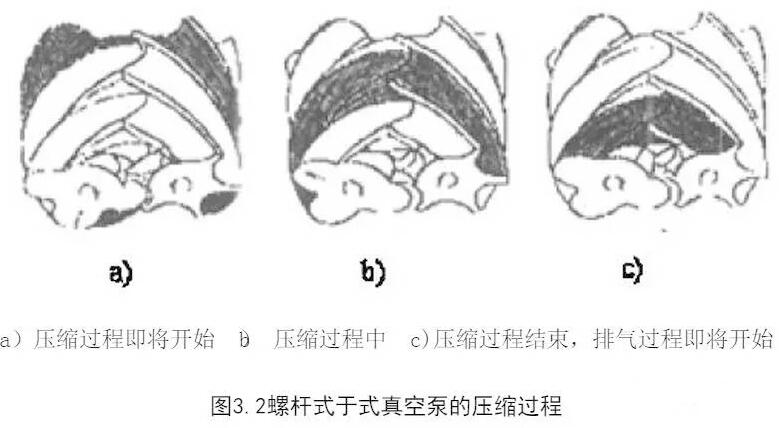
Figure a shows the rotor position at the beginning of the screw pump compression process. At this time, the gas is surrounded by the rotor teeth and the casing in a closed space, and the volume between the teeth will begin to decrease due to the meshing of the rotor teeth. With the rotation of the rotor, the volume between the teeth decreases continuously due to the meshing of the rotor teeth. The occupied volume of the gas sealed in the volume between teeth also decreases, resulting in an increase in pressure, thus realizing the gas compression process, as shown in Fig. B. The compression process can continue until the volume between teeth is about to be connected with the exhaust orifice. As shown in Figure C.
3 .Exhaust process
The following figure shows the exhaust process of the screw pump. When the volume between teeth is connected with the exhaust orifice, the exhaust process begins. As the volume between teeth decreases, the gas with exhaust pressure is gradually discharged through the exhaust orifice, as shown in Fig. a.
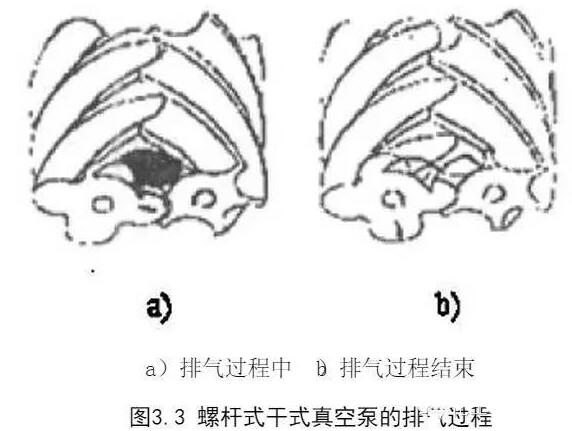
Dry Screw Vacuum Pump Characteristics:
1. High reliability. The screw dry vacuum pump has few parts and no vulnerable parts, so it runs reliably and has a long service life.
2. Easy operation and maintenance.
3. Good dynamic balance. The screw dry vacuum pump has no unbalanced inertia force, and the machine can run smoothly and at high speed.
4. Strong adaptability. The screw dry vacuum pump has the characteristics of forced gas transmission. It can maintain a high pumping speed in a wide range of pressure, and the exhaust volume is almost unaffected by the exhaust pressure.
5. Multiphase Mixed Transport. Because there is a small gap between the tooth surfaces of the rotor of the screw dry vacuum pump, it can remove corrosive, toxic, dust, condensable vapor and other gases.
Screw Dry Vacuum Pump Application :
Screw dry vacuum pumps are widely used in electronics, nuclear energy, chemical industry, medicine, food industry and other fields. In the semiconductor industry, it is used to produce chips, liquid crystal displays, etching and CVD process of PLASMA. In nuclear industry, it is used for vacuum acquisition in nuclear reactor and nuclear industry; in chemical industry, it is used for vacuum distillation and solvent extraction to recover solvents efficiently; in fatty acid production, it is used to eliminate water pollution and remove obstructions in ejectors; in pharmaceutical industry, it is used to recover pharmaceutical liquid and drug intermediates, to provide clean sterile conditions for the production of artificial organs, and to recover gas disinfectants; in food industry, it is used for perfume. Flavor concentrate, food packaging and so on. It has a wide range of applications. Specifically as follows:
Specific applications: drying treatment, vacuum distillation, molecular distillation, solvent recovery, oil and gas recovery, factory ordinary vacuum, electronics, vacuum coating, aviation, nuclear industry can extract ordinary air, flammable and explosive gases, corrosive gases, especially to meet the requirements of a clean vacuum environment. Specific applications: vacuum coating, vacuum distillation, vacuum drying, pulling single crystal, special gas manufacturing, ion etching, etc.
Dry vacuum pumps are used in textile and metallurgical industries in spandex, aramid, fibre, metallurgy and other related processes, such as vacuum defoaming, VOD vacuum oxygen blowing decarbonization, etc.
One is the semiconductor industry, which requires the vacuum pump to return to zero in the pumped space to protect the workpiece from pollution. The requirements for vacuum systems used in semiconductor industry are generally divided into three levels. (1) Only air or air containing a little water vapor is pumped out under clean conditions; (2) Reactive gases in the process are pumped out under medium conditions, but there are no solid particles; (3) Chemical reactants (toxic or even carcinogenic) and solid particles are pumped out under harsh conditions.
The other is represented by the petrochemical industry, which requires vacuum pumps to extract a large number of condensable gases, or corrosive gases, or toxic gases, or gases containing micro-dust. Screw dry vacuum pumps are widely used in electronics, nuclear energy, chemical industry, medicine, food industry and other fields. In the semiconductor industry, it is used to produce chips, liquid crystal displays, etching and CVD process of PLASMA. In nuclear industry, it is used for vacuum acquisition in nuclear reactor and nuclear industry; in chemical industry, it is used for vacuum distillation and solvent extraction to recover solvents efficiently; in fatty acid production, it is used to eliminate water pollution and remove obstructions in ejectors; in pharmaceutical industry, it is used to recover pharmaceutical liquid and drug intermediates, to provide clean sterile conditions for the production of artificial organs, and to recover gas disinfectants; in food industry, it is used for perfume. Flavor concentrate, food packaging, etc.
4 .Reciprocating Vacuum Pump

Reciprocating Vacuum Pump Working Principle:
Reciprocating vacuum pump (also known as piston vacuum pump) is one of the low vacuum acquisition equipment. Its limit pressure is generally 1330-2660P reciprocating vacuum pump (referred to as reciprocating pump), also known as piston vacuum pump, which belongs to one of the low vacuum acquisition equipment. Compared with the rotary vane vacuum pump, it can be made into a pump with large pumping speed, and the efficiency is slightly higher than that of the water ring vacuum pump. The main drawbacks of this kind of pump are its complex structure, large volume and large vibration in operation.

The working principle of reciprocating vacuum pump is shown in the figure above. The main components of reciprocating vacuum pump are cylinder 1 and piston 2, in which the reciprocating linear motion occurs. The driving of piston is accomplished by crank connecting rod mechanism 3 (including cross head).
In addition to the main components mentioned above, there are important components such as exhaust valve 4 and suction valve 5, as well as auxiliary components such as seat, crankcase, dynamic seal and static seal. When running, driven by the motor, the piston in the cylinder moves to and fro through the action of crank-connecting rod mechanism (rotating motion into linear motion). When the piston moves from the left end to the right end in the cylinder, the pressure in the left chamber space decreases continuously as the volume of the left chamber of the cylinder increases. When the pressure in the left chamber space is lower than that in the pumped container, according to the principle of gas pressure balance, the gas in the pumped container is continuously pumped into the left chamber through the suction valve 5, which is in the process of suction.
When the piston reaches its rightmost position, the left chamber of the cylinder is filled with gas. Then the piston moves from the right to the left, and the suction valve 5 closes automatically. Gas is gradually compressed as the piston moves from right to left. When the gas in the cylinder reaches the exhaust pressure, the exhaust valve 4 is opened and the gas is discharged, thus completing a working cycle. When the piston moves from the left end to the right end, repeat the above-mentioned cycle, so as to achieve a stable equilibrium pressure in the pumped container to improve the pumping efficiency. Generally, there are suction valves and exhaust valves at both ends of the cylinder. Then, the suction and exhaust ports at both ends of the cylinder are connected in parallel by pipeline.
Reciprocating vacuum pump has a wide range of pumping speed, ranging from 50L/S to 600L/S. It is suitable for vacuum impregnation, vacuum treatment of molten steel, vacuum distillation, vacuum evaporation, vacuum concentration, vacuum crystallization, vacuum drying, vacuum filtration and vacuum operation of concrete in petroleum, chemical, pharmaceutical, food, light industry, metallurgy and electrical industries. Reciprocating vacuum pumps are not suitable for pumping gases with excessive oxygen, explosive, corrosive to metals, and particulate dust, nor for conveying gases from one container to another. Reciprocating vacuum pump is suitable for pumping non-solid particles, non-corrosive gas. This kind of vacuum pump has higher pumping rate and higher vacuum. Therefore, it is widely used in chemical plants. But its structure is complex and its maintenance is large.
Reciprocating vacuum pump is one of the main equipment to obtain rough vacuum. It is used to extract vacuum or other gases from closed containers or reaction pots. It is not suitable for extracting corrosive gases or gases with hard grained ash powder.
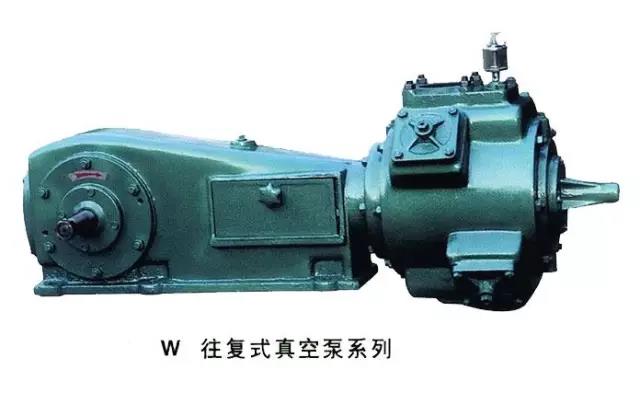
Reciprocating vacuum pump structure :
1. Mechanical transmission part and gas flow part of reciprocating vacuum pump. The whole structure of the mechanical transmission part is installed in a closed body, and the crankshaft is supported in tapered roller bearings on both sides of the body.
2. One end of crankshaft of reciprocating vacuum pump is equipped with a large pulley to drive the transmission part. The connecting rod connects the crankshaft journal with the cross head. One end of the piston rod is rotated into the screw hole of the cross head, and the other end is installed in the cone hole of the piston and fixed by a nut.
3. The motor of reciprocating vacuum pump and the small pulley mounted on the shaft drive the crankshaft to rotate through the triangular tape, so that the piston can reciprocate in the cylinder through the action of connecting rod and cross head.
4. When the connecting rod crankshaft mechanism of reciprocating vacuum pump moves in the body, the oil in the oil pool splashes to lubricate the friction surfaces of bearings, crankshaft necks, crossheads and slideways. In order to facilitate inspection and maintenance of the transmission mechanism, removable door covers are installed on both sides and behind the body, and oil windows are installed on the back cover to indicate the oil level of the oil pool in the body.
Reciprocating Vacuum Pump Application:
W-type reciprocating vacuum pump has been widely used in various industrial sectors, such as vacuum distillation, evaporation, crystallization, drying and filtration in chemical or food industry, degassing in vacuum metallurgical industry, and infiltration in electrical industry. It is not suitable for pumping gases with excessive oxygen, explosive, corrosive to metals, chemical reactions with pump oil and particulate dust, nor for conveying gases from one container to another for conveying pumps. Therefore, the selection of chemical and pharmaceutical industries should be cautious.
Reciprocating vacuum pump type selection instructions:
Reciprocating vacuum pump product name and model, reciprocating vacuum pump pipe diameter, reciprocating vacuum pump using lift (m), reciprocating vacuum pump motor power (KW), reciprocating vacuum pump motor speed (r/min), reciprocating vacuum pump voltage [V], reciprocating vacuum pump using suction (m), reciprocating vacuum pump using medium name, specific gravity, viscosity, corrosiveness, corrosiveness, etc. Toxicity.
5.Jet Vacuum Pump
Steam ejection vacuum pump has a certain pressure work, steam through the Laval nozzle, decompression and speed-up (steam potential energy into kinetic energy) is injected into the mixing chamber at supersonic speed, mixing with the pumped medium, energy exchange, mixed gas into the diffuser, deceleration and pressurization (kinetic energy into pressure energy). In order to reduce the pumping load of the later stage pump, a condenser is equipped, through which the pumped medium is mixed. Two kinds of medium with a certain temperature difference convection, heat exchange, to achieve the purpose of condensing high-temperature medium, discharged to atmospheric pressure. (See figure below for principle)
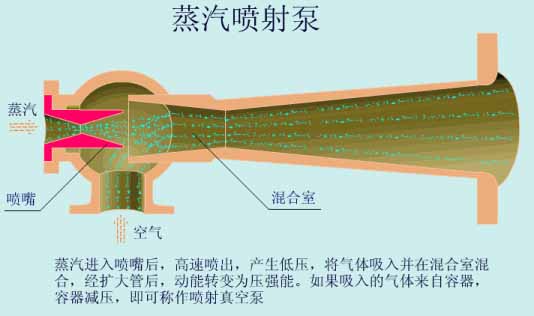
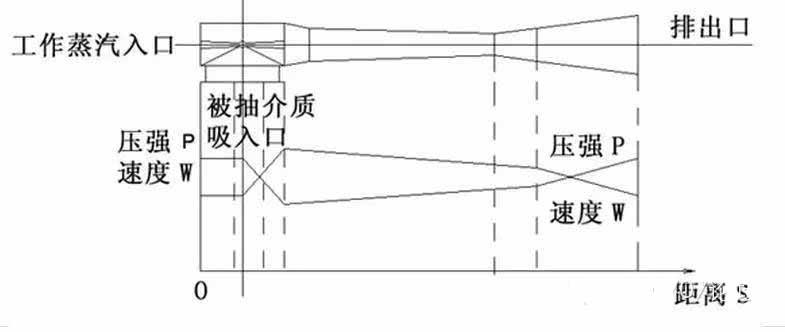
The internal components of jet vacuum pump mainly consist of Laval nozzle and diffuser. The structure of single-stage steam jet pump is shown in Fig. 1. The structure of other levels is basically the same.
Its working process can be divided into three stages: adiabatic expansion stage, mixing stage and compression stage.
In the adiabatic expansion stage, the pressure energy is converted into velocity energy after the working steam passes through the scaling nozzle, and enters the diffuser at a very high speed. At the same time, the pressure of the working steam decreases at the nozzle outlet, forming a vacuum to inhale the pumped gas.
In the mixing stage, the exhausted gas enters the diffuser. In the diffuser, the vapor and the exhausted gas collide and mix, exchange energy, and mix at the throat of the diffuser. The two gases reach the same speed.
In the compression stage, after passing through the throat of the diffuser, the velocity of the mixture decreases and the pressure rises further. At the outlet of the diffuser, the atmospheric pressure or the inlet pressure of the second stage ejector are reached, and the exhausted gas is discharged.
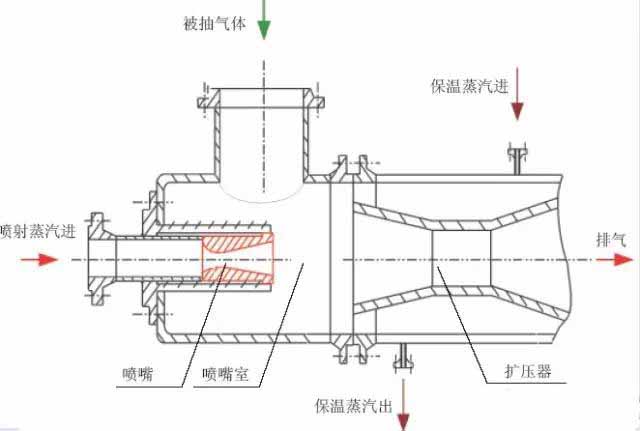
Water Jet Vacuum Pump Structural Advantages :
The water jet vacuum pump consists of the body, cover, nozzle, nozzle seat plate, guide plate, diffuser tube and one-way valve. The nozzle is made of stainless steel, the nozzle seat plate is processed by high quality steel, the other parts are cast iron, and the nozzle adopts the structure of multiple nozzles, so as to obtain a larger water-vapor contact area, which is conducive to heat exchange and obtain a better vacuum effect. 。 The nozzle seat plate is precisely machined and has high precision, so that the jet water can accurately gather in the same focus. The guide disc is used to slow down the flow rate of steam (or air) so that the steam is evenly introduced into the chamber to avoid the deviation of the jet flow and reduce the efficiency of pumping. The whole device of water jet vacuum pump has compact structure and high strength. It is used in vacuum evaporation system. Because it can combine the condensation function of condenser with the pumping function of vacuum pump in one device, it greatly simplifies the process flow. Compared with the original device of vacuum pump and old condenser, it can save the equipment of
vacuum air pump, condenser and water distributor. And there are the following advantages:
(1) Hydraulic injection has small volume, light weight and compact structure. And the efficiency is relatively high, the power consumption is lower than the vacuum system, and the investment is low.
(2) Simple operation and convenient maintenance, without the need for full-time personnel to take care of
Jet Pumps Types :
Jet pump is a kind of fluid action pump, which uses the energy conversion of fluid flow to achieve the conveying flow. The working fluid of the jet pump can be steam, air, water and oil. Jet vacuum pump, also known as jet vacuum pump, uses the high-speed jet of the nozzle to extract the gas from the container to obtain vacuum. It is mainly used as a vacuum pump in chemical production and widely used in evaporation and distillation process.
The working fluid of jet pump can be steam, water or other liquids or gases. The working steam is ejected at a high speed through the nozzle at high pressure. During the ejection process, the static pressure energy of the steam is converted into kinetic energy, thus creating a low pressure zone at the suction port, which sucks the conveyed fluid. After mixing the inhaled fluid with steam, it enters the enlarged tube, the flow velocity decreases gradually, and the pressure increases accordingly, and discharges from the pressure outlet.
1. Steam Jet Pump
The working medium of steam jet pump is water vapor, which is a jet vacuum pump that can directly exhaust the atmosphere. As shown in Fig. 1115, the working process is divided into three stages: first, the adiabatic expansion stage, in which the working steam expands adiabatically through the nozzle, and the working steam converts its pressure energy into velocity energy and sprays out at a high speed; second, the mixing stage, in which the working steam mixes with the exhausted gas and exchanges energy between the two streams, the velocity of the exhausted gas is obtained. When it reaches the throat of the diffuser, the kinetic energy is transformed into potential energy. When it reaches the throat of the diffuser, the mixing phase is completed and the two airflows reach the same speed, and then it is diffused to further reduce the speed and pressure. Expansion, and then will be pumped out of the ejector gas, thus completing the steam jet pump work process.
2. Air jet pump
The working principle of air jet pump is similar to that of steam jet pump, but its working medium is compressed air or atmospheric air. According to whether the working medium is high pressure air or atmospheric air, it can be divided into general air jet pump and atmospheric jet pump.
General air jet pumps have to be equipped with large capacity air compressors because of the large consumption of working media; general air jet pumps. Most of them are used in single stage.
Atmospheric jet pump usually works in series with one or two to three stages, and is usually installed in the inlet VI of water ring vacuum pump to form a high vacuum unit, in order to improve the limit vacuum degree and expand the working pressure range of water ring vacuum pump.
3. Water jet vacuum pump
When the vacuum requirement is not too high, a certain pressure of water can be used as the working medium of the water jet vacuum pump. The speed of water injection is usually about 15-30m/s. Although it belongs to the coarse vacuum device, it has the dual function of producing vacuum and condensation steam, so it has been widely used. The working principle of water jet vacuum pump is similar to that of steam jet pump, and its efficiency is usually less than 30%.
Jet Pump Application:
Jet vacuum pump has the advantages of simple structure, easy manufacture, no moving parts, easy failure and low maintenance workload. It can transport fluids with high temperature, corrosiveness and solid particles. But its efficiency is low, generally about 25%-30%. In petrochemical production, jet pumps are not only used to replace mechanical vacuum pumps, but also widely used in mixers, coolers, absorbers and so on.
Jet pumps are widely used in conveying and compressing mixed gases and vapors, liquids and solids. Gases or liquids are often used as power media. Jet pump is another very important application for generating vacuum.
Jet pumps are suitable for high temperature, high pressure and high vacuum fields, such as vacuum evaporation, vacuum drying, vacuum refrigeration, vacuum distillation, lifting liquid, alkali or suspension containing abrasives, and also for special environment with strong radiation.
Jet Pump in Vacuum Generation Application:
1. Because of the diversity of jet pump, it has been widely used in various fields, such as chemical reactor, exhaust system, water treatment equipment, mixing tank, storage tank, wastewater treatment equipment, heating system, heating gas supply system, power plant, swimming pool, salmon factory water supply, etc. And the formation of vacuum in different industrial fields.
2. Vacuum formation of jet pump with steam as power medium is an important application field. The high-speed jet is several times the speed of sound, so the jet pump can also easily handle large-capacity materials in vacuum.
3. Because single-stage jet pump can only overcome extremely limited compression ratio, when the suction pressure is low, several jet pumps must be installed in series. The suction pressure of multi-stage steam jet vacuum pump can reach as low as 0.01 mbar. In order to condense most of the power steam and minimize the suction capacity of the next stage, a condenser is usually placed between two jet pumps. According to the application situation, direct contact condenser or surface condenser is used.
4. Water vapor is the main power medium in jet pump. In most industries, water vapor is produced in large quantities as a basic energy, so it is very easy to obtain. In the condensation process of power steam, wastewater will be produced more or less. Although the quantity is very small and the steam jet pump is still the most economical vacuum pump even if the discharge cost of wastewater is taken into account, it always has a negative impact on the vacuum jet pump.
5. As an alternative, product steam is increasingly used in the operation of jet pumps. For example, solvent vapor, chlorobenzene, toluene, butanediol, ethylene, ethylene glycol, furan.
6. In this case, the evaporation of power steam after condensation is used as power medium. Owing to the low evaporation temperature of organic steam, in most cases, this method of operation is more conducive to saving energy than steam operation.
7. Another important operating range of jet pump using product steam as power medium is that water is not allowed to be mixed into process materials. In order to obtain the best efficiency, the jet pump using product steam as power medium still needs to be studied in detail.
8. Advantages of jet pump: As far as structure and function are concerned, this kind of jet pump has no big difference with vacuum jet pump using steam as power medium, and has the same advantages: simple structure; safe and reliable operation without maintenance; long service life and wear resistance; suitable material selection can be corrosion-resistant; all materials can be manufactured. In addition, due to the recycling of condensate, there is no emission pollution.
Jet vacuum pumps are used in various industrial fields. The following are several important applications.
1. GEA Jet Pump Company has developed combined pumps in chemical industry and has been widely used. This pump is characterized by compact shape and dual design. Two parallel pumps can operate independently and alternately or simultaneously, so they may be repaired without stopping.
2. In chemical industry, if stainless steel can not meet the requirements of corrosion resistance, ceramic/graphite vacuum jet pump can be used to remove corrosive gas and water vapor. The jet pump is made of ceramics and the surface condenser is made of graphite. Surface condenser is a compact combination of condensers. This structure has the advantages of small size, less space and simple field assembly.
3. In refineries, the combination of steam vacuum jet pump and liquid ring pump is used in vacuum distillation column system of refineries. The combination of the two pumps maintains very low consumption of steam, water and electricity. The steam vacuum jet pump of GEA Jet Pump Company is very suitable for this purpose because of the large amount of gas that can be transported (in the range of 104-106 m3/h). At the same time, the operation is safe and reliable, and it is not easy to break down.
4. Similarly, the case involving large volume flow is in the vacuum generation of degassing in steelmaking. In order to produce a certain quality of steel, the treatment of some raw steel needs to be carried out in vacuum. This vacuum pump must have two functions. One is to quickly empty the container to achieve the required pressure. This means that the initial suction capacity of the vacuum jet pump must be very large (thousands of kg/h). The second is to remove a large number of inert gases (about 0.6 mbar, several hundred kg/h) while maintaining low pressure.
5. In addition, vacuum jet pumps are also used for deodorization of edible oils, production of polymers from chemical syntheses, desalination of seawater, dehydration of oil, conditioning of food, beverage and tobacco, suction of spinning baths and many other applications.
(The article comes from the Internet. If reprinting is not allowed, please contact our company to delete it.)
